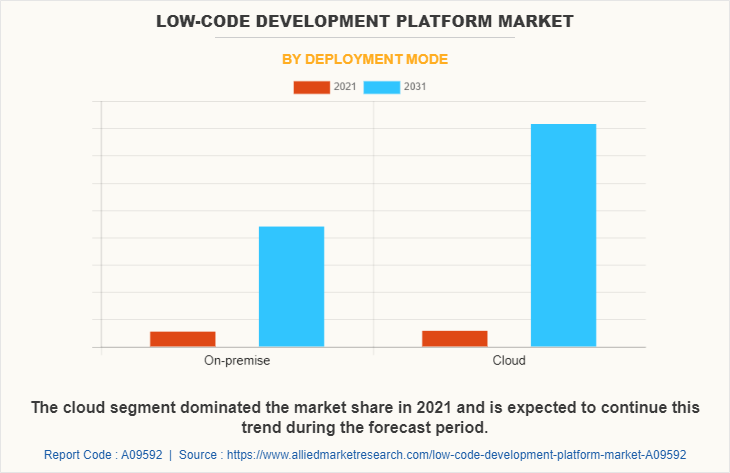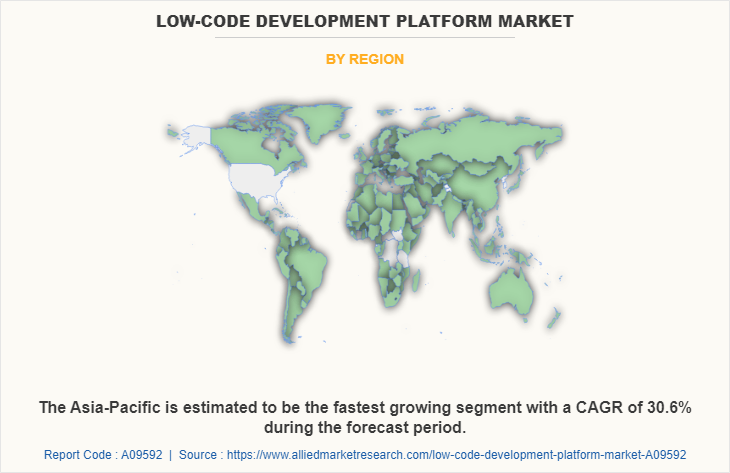Low-Code Development Platform Market Insights, 2031
The global low-code development platform market was valued at USD 11.5 billion in 2021, and is projected to reach USD 125.6 billion by 2031, growing at a CAGR of 27.4% from 2022 to 2031.
Factors such as growing digitalization and social media penetration around the world are positively impacting the growth of the market. In addition, increase in the adoption of low-code development platform across businesses to enhance operation & productivity, drives the growth of the market. Furthermore, increase in investments in the sectors such as BFSI, healthcare, and others is expected to provide lucrative growth opportunities for the market during the forecast period. Moreover, low-code development platform helps to reduce costs over the entire development lifecycle, which is expected to create numerous opportunities for the market growth during the forecast period. However, concerns over low-code development platform’s security and compliance are growing, especially for apps that use consumer data, this factor is expected to hamper the growth of the low-code development platform market.

A low-code development platform provides a development environment used to create application software through a graphical user interface. A low-coded platform may produce entirely operational applications or require additional coding for specific needs of the business. In addition, it can reduce traditional work time, enabling faster delivery of business applications. A common benefit is that a wider range of people can contribute to the application's development. Not only those with coding skills but also with good governance to be able to adhere to common rules and regulations.
Furthermore, it can also lower the initial cost of setup, training, deployment, and maintenance. Such advantages provide lucrative opportunities for the low-code development platform market trends during the forecast period. Moreover, emerging advanced low-code development platform applications can solve a variety of human errors and quality issues. Hence, various sectors such as healthcare, IT, retail, and others are adopting low-code development platform due to its benefits. Wide adoption of this platform across various sectors is the major factor expected to create lucrative growth opportunities in the market.
Segment Review
The low-code development platform market is segmented into component, deployment mode, application type, organization size, industry vertical, and region. By component, it is bifurcated into platform and services. By deployment mode, it is divided into on-premise and cloud. Based on application type, it is divided into web-based, mobile-based, and desktop & server-based. By organizational size, the market is segregated into small & medium-sized enterprises and large enterprises. By industry vertical, the market is classified into BFSI, IT and telecom, manufacturing, healthcare, retail and e-commerce, government, and others. Region wise, it is analyzed across North America, Europe, Asia-Pacific, and LAMEA.

On the basis of deployment mode, the global low-code development platform market share was dominated by the cloud segment in 2021 and is expected is expected to continue this trend during the forecast period, owing to easy access and low costs.

By region, North America accounted for a dominant market share in the low-code development platform market in 2021. This is due to an increase in investment in advanced technologies such as low-code development platforms to improve businesses and the customer experience is anticipated to propel the growth of the market. However, Asia-Pacific is expected to exhibit the highest growth during the forecast period. This is attributed to increase in penetration of digitalization and higher adoption of cloud-based services are expectecd to provide lucrative growth opportunities for the market in this region.
Top Impacting Factors
Increase in Demand for Business Digitization
Organizations operating in BFSI, manufacturing, automotive, energy & utilities, and several other verticals are forced to adopt digital technologies to stay ahead in the market owing to the digital transformation. Low-code development platform plays a critical role in the digital transformation journey of an organization as it helps to reduce time and resources, as compared to the traditional software development process. With the increase in demand for business applications across industries, the platform is expected to play a pivotal role in enabling quick digitization of business processes, such as sales, accounting and finance, and operations. Thus, the rise in focus on digitization results in increase in growth of the low-code development platform market, globally. Furthermore, increase in the use of cloud-based software development, machine learning, and artificial intelligence (AI) is further accelerating the growth and quality of this industry.
Less Dependency on IT Professionals
Application development backlog is the major obstacle faced by the IT department across industries. Numerous business departments, such as human resources (HR), operations, and accounting & finance, require different applications to improve process efficiency; however, interruption in applications’ delivery affects overall productivity. Organizations have started to adopt low-code solutions to reduce the workload on the IT department. These low-code solutions help citizen developers (non-professional developers) develop business applications, reduce the overall cost, and minimize the workload for IT professionals, which, in turn, drives the growth of the low-code development platform market. Furthermore, based on several studies, it is noted that a low-code platform is never a replacement for a firm’s existing IT department. Instead, low-code functions as an extension of the IT team, which allows for better collaboration between the organization and IT.
Stringent Government Norms Moderately Impact the Market
With the growing number of data breaches, the European Union has introduced General Data Protection Regulation (GDPR) Act, which defines how organizations are permitted to use personal data. Therefore, organizations need to comply with such strict regulatory norms before processing personal data, which complicates the application development process. However, with low-code development platform, organizations can develop business applications in compliance with governments’ rules and regulations. Therefore, stringent government regulatory norms are projected to drive the growth of the low-code development platform industry, globally.
COVID-19 Impact Analysis
The low-code development platform market has witnessed significant growth in the past few years. The COVID-19 pandemic has increased business's need to automate processes and prioritize digital transformation initiatives. Low-code development platforms address this need, helping streamline workflows and accelerate automation projects. A low-code model promotes rapid application development by making the user experience more accessible. Both non-professional and professional developers benefit from core capabilities, such as a visual integrated development environment (IDE), built-in data connectors and/or APIs, and code templates. All these functionalities of low-code tools improve the DevOps process, allowing more time for innovation.
According to Magic Quadrant Report, it is anticipated that over 50% of medium to large companies will adopt a low-code application platform in the upcoming years. Furthermore, many businesses have invested in low-code development platform to ease the increasing complexities of IT needs during the forecast period.
Furthermore, low-code development platforms greatly benefit enterprises by breaking down boundaries between IT and business analysts. Business users can bring innovative ideas to life by just dragging and dropping readymade elements or code snippets. These proof-of-concept apps simplify the life of programmers who can use them as a starting point when building enterprise software. Businesses can streamline, automate, and standardize manual internal processes so that developers are not overburdened and can focus on higher-value tasks. Minimizing overwhelming coding needs gives IT relief from the pressure of their oftentimes unconquerable app backlog. This eliminates the need for businesses to employ risky third-party apps outside their certified IT infrastructure. Such factors are anticipated to create numerous opportunities for the market players during the forecast period.
Moreover, businesses are shifting towards digitalization and increasing implementation of Industry 4.0, which creates the need for a seamless solution and platform to meet business requirements. Therefore, it eventually escalates the adoption of low-code development platform in industries rapidly. Thus, it is predicted to drive the growth of the low-code development platform market forecast.
Key Benefits for Stakeholders
- The study provides an in-depth low-code development platform market analysis along with the current trends and future estimations to elucidate the imminent investment pockets
- Information about key drivers, restraints, and opportunities and their impact analysis on the low-code development platform market size is provided in the report
- The Porter’s five forces analysis illustrates the potency of buyers and suppliers operating in the low-code development platform industry
- The quantitative analysis of the global low-code development platform market for the period 2021–2031 is provided to determine the low-code development platform market potential
Low-Code Development Platform Market Report Highlights
| Aspects | Details |
| Market Size By 2031 | USD 125.6 billion |
| Growth Rate | CAGR of 27.4% |
| Forecast period | 2021 - 2031 |
| Report Pages | 405 |
| By Deployment Mode |
|
| By Enterprise Size |
|
| By Application Type |
|
| By Industry Vertical |
|
| By Component |
|
| By Region |
|
| Key Market Players | Zoho Corporation Pvt. Ltd., ServiceNow, Inc., OutSystems, Inc., Salesforce.com Inc., Appian Corporation, Oracle Corporation, AgilePoint Inc., Microsoft Corporation, Pegasystems Inc., Mendix Technology BV |
Analyst Review
According to CXOs of the leading companies, over the time, businesses have witnessed various changes in business processes, operations, and industrial automation. With the increase in customer expectations and the rapid digital transformation in the past few years, software development teams have faced lots of challenges. They are expected to deliver much more sophisticated applications in increasingly shorter timelines while maintaining, managing, and evolving the existing app portfolio at the same time. In addition, businesses are also struggling to hire new developer talent, as there are not enough engineers to fulfill the current development needs. Low-code development platform provides the capabilities that allow organizations to close this gap.
Low-code provides the necessary automation tools to boost developer productivity and help teams to defeat those increasing backlogs. By boosting developer productivity, organizations regardless of their size are able to do more work with the same resources. Such factors are anticipated to drive the growth of the market in the upcoming years. In addition, some low-code programming tools also empower business technologists to create their own applications. Others promote collaboration between business and IT, enabling organizations to benefit from developer knowledge and business expertise. Such factors create lucrative opportunities for the low-code development platform market during the forecast period.
Furthermore, low code applications cover a much broader range of use cases, including enterprise and business-critical apps. In addition, it provides advanced capabilities, such as AI automation and automated testing, to make the development process more efficient. These factors are projected to offer numerous opportunities for the market growth in the upcoming years. Moreover, it promotes collaboration between business and IT as well as promotes modern development practices, such as DevOps and cloud app development.
Nevertheless, prominent market players are exploring new technologies and applications to meet the increase in customer demands. Product launches, collaborations, and acquisitions are expected to enable them to expand their product portfolios and penetrate different regions.
The global low-code development platform market was valued at USD 11.5 billion in 2021, and is projected to reach USD 125.6 billion by 2031.
The global low-code development platform market is projected to grow at a compound annual growth rate of 27.4% from 2021-2031 to reach USD 125.6 billion by 2031.
AgilePoint Inc., Microsoft Corporation, Oracle Corporation, OutSystems, Inc., Pegasystems Inc., Salesforce.com Inc., ServiceNow, Inc., Zoho Corporation Pvt. Ltd. and others
North America is the largest market for the Low-Code Development Platform.
Factors such as growing digitalization and social media penetration around the world are positively impacting the growth of the market.
Loading Table Of Content...


